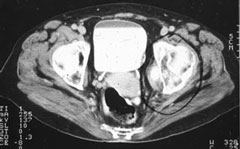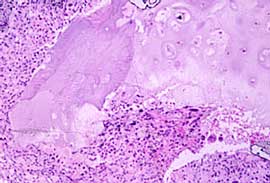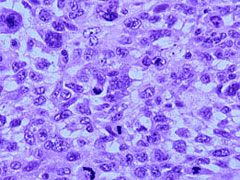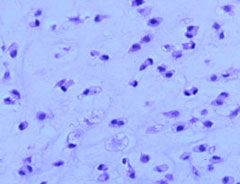|
|
|
Case #14
|
Typical Clinical Presentation:
|
|
A 56-year-old female presented with a rapidly growing, large, destructive lesion in the pelvic bones.
|
|
|
|
Characteristic Radiological Findings:
|
|
|

|
-
CT scan of the pelvis shows a destructive bone lesion, which extends through the cortex into the soft tissues.
|
|
|
|
Pathological Findings: :
|
|
|

|
-
Microscopic examination reveals a distinguishing feature of this entity.
That is the presence of two distinct components: a low-grade cartilaginous neoplasm and a
high-grade sarcoma.
|
|
|

|
-
High-grade component has the morphology of MFH. Numerous mitoses including
atypical mitoses are present.
|
|
|

|
-
The cartilaginous component is a low-grade chondrosarcoma (Grades 1 to 2).
|
|
|
Diagnosis: Dedifferentiated Chondrosarcoma
|
|
Salient Points::
|
-
Dedifferentiation means transformation of a low-grade (grades 1 or 2)
chondrosarcoma into a high-grade sarcoma, most often with features of MFH or osteosarcoma.
By definition, the hallmark of dedifferentiated neoplasm is the co-existence of two
components, a low-grade lesion and a high-grade sarcoma, with abrupt demarcation between them.
This feature distinguishes dedifferentiation from a gradual increase in grade.
Clinically, dedifferentiation is heralded by a sudden increase in aggressiveness
(eg., development of a rapidly growing soft tissue mass).
-
Most patients are older than 50 years.
-
Prognosis. This variant of chondrosarcoma is associated with a very low survival rate.
The response to treatment is poor and widespread metastases are the rule.
- Experimental data:
Controversy remains as to whether both components of dedifferentiated chondrosarcoma are derived from a common precursor cell or they represent two separate lineages (collision tumor). The current hypothesis is that "high-grade components represent a failure of differentiation, rather than de-differentiation of mature chondroid cells". In a recent study by Bovee et al, molecular genetic characterization of both components of a dedifferentiated chondrosarcoma has provided evidence for a monoclonal origin and has suggested that the separation may be an early event in the histogenesis of this tumor.
Available publications for the topic:
Dedifferentiated Chondrosarcoma
|
|
Selected References::
|
- Bovee JVMG, Cleton-Jansen AM, Rosenberg C, Taminiau AHM, et al. Molecular genetic characterization of both components of a dedifferentated chondrosarcoma, with implications for its histogenesis. J Pathol 1999;189:454-462
|



